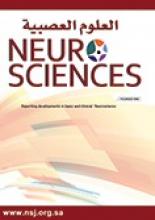Abstract
OBJECTIVE: To ascertain the most prevalent risk factor for stroke.
METHODS: We performed a descriptive and analytical prospective study on patients with stroke admitted to the neurology wards of Imam Hospital, Tabriz, Iran during 2004 and 2005. The study comprised 100 ischemic stroke (IS) patients consisting of 46 men and 54 women with a mean age of 67 +/- 15, and 100 age and gender matched apparently healthy subjects. Plasma levels of C-Reactive protein (CRP), fibrinogen, platelet counts, lipoprotein (a) (LP (a)), high-density lipoprotein cholesterol (HDL-c), low-density lipoprotein cholesterol (LDL-c), total cholesterol (TC), and triglycerides (TG) were measured in both patients and controls. Background disease was also investigated in the patients. Hemorrhagic and embolic stroke patients were excluded from the study.
RESULTS: We found no significant difference in serum fibrinogen, HDL-c levels, and platelet counts between patients and control subjects, however, levels of LP (a), TG, LDH-c, and CRP were significantly higher in patients than controls. Among the predisposing background illnesses, the most common risk factors were hypertension and hyperlipidemia. The frequency of studied risk factors among patients was: no risk factors (20%), one risk factor (32%), 2 risk factors (36%), and 3 risk factors (12%).
CONCLUSION: Hypertension was the most prevalent background disease in IS patients. We also found that although there is close relationship in the incidence of IS with levels of LP (a), TC, TG, LDL-c, and CRP, the cutoff point frequency of fibrinogen, CRP, LP (a), and platelet counts was variable from patient to patient.
- Copyright: © Neurosciences
Neurosciences is an Open Access journal and articles published are distributed under the terms of the Creative Commons Attribution-NonCommercial License (CC BY-NC). Readers may copy, distribute, and display the work for non-commercial purposes with the proper citation of the original work.






